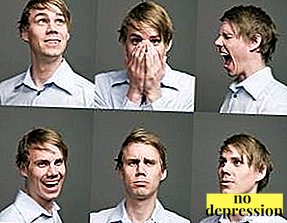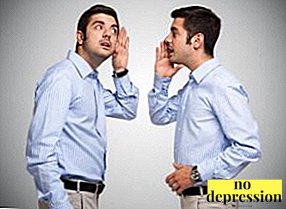We are the people. We are accustomed to communicate through speech and hope that the impression about us is formed on the basis of what we say. But it has long been proved that body communication, defined as non-verbal means of communication, is of greater importance.
Pose and glance, facial expressions and gestures, tone and timbre of voice, rate of speech - these indicators can accurately determine the state of a person and his attitude to you. Body language is often truer than the words you say. The proportion of non-verbal component is large: from 60 to 80 percent of personal communication takes place without speech.
The content of the article:
Categories
Facial expressions, postures and gestures
Psychologist's comment
If you want to find out how you are really treated, feel at ease in any situation, without words win over the interlocutor or, conversely, make it clear that he is not interested in you - read and translate body language, because very informative. What are non-verbal ways of communication.
Spatial categories
The phrase "stay away" often sounds in relation to people whom you fear or dislike. And vice versa, “stay close” is an indicator of interest in a partner. The more important a person is to us, the closer we try to get close to it.
 Each has its own, jealously guarded, personal space. Invasion is not allowed to everyone: intimate relationships suggest a distance of 45 cm or less, friendly - 45-120 cm, social and business from one to one and a half meters. These standards depend on age, gender and level of culture, social status and traditions.
Each has its own, jealously guarded, personal space. Invasion is not allowed to everyone: intimate relationships suggest a distance of 45 cm or less, friendly - 45-120 cm, social and business from one to one and a half meters. These standards depend on age, gender and level of culture, social status and traditions.
Understanding will be easier if you and your partner are on the same level. When you "rise" above the interlocutor, he can perceive you as threatening and overwhelming.
Facial expressions: read minds
Our face is an indicator of state and mood. If you want to understand a person better, pay attention to his emotional zone - cheeks, cheekbones, nose and mouth. The bending of the lips, even for a moment, will reflect on the face the emotions that are owned by the interlocutor. Do not miss this moment.
A smile can say more about a person than he would like to express with her. Thus, an excessive smile "signals" the need for approval or respect for the "superior". If a person smiles, raising his eyebrows, it is a signal of readiness to obey; parted lips with lowered eyebrows claim superiority.
If you suspect a partner in hypocrisy, carefully watch him. Trying to keep facial expressions under control, a person will pay less attention to other aspects of body language. Sly will give out uncontrolled movements, contrary to facial expression and spoken words.
The innate ability to recognize non-verbal signals, supplemented by the experience of raising small, unable to speak children, is well developed in women.
Pose and gestures: decipher
The movements of the arms and legs, the position of the body, the inclination of the head as non-verbal means in communication translate quite “readable” meanings:
- partner evaluation - scratching the chin, getting up and walking back and forth, touching the cheek;
- self-confidence - swaying on a chair, connecting fingers in the "house";
- insecurity and nervousness - tapping with the fingers on the table, interlacing them, tingling the palm;
-
 self-control - sitting on a chair, clinging to the armrest; putting your hands behind your back;
self-control - sitting on a chair, clinging to the armrest; putting your hands behind your back; - protection or denial - arms crossed on the chest, body deflected backwards;
- waiting - rubbing the palms;
- location - hands pressed to the chest, the desire to be closer to the interlocutor;
- rejection, insincerity - touching the tip of the nose, covering the mouth, deviating away from your partner, wandering eyes.
Motility (body position, gestures and movements) will allow you to determine the feelings and attitudes of people. Close friends usually stand or sit side by side. For unfamiliar people negotiating, for example, it is more convenient to talk, facing each other. If the speaker is leaning toward you, this is a sign of attention, courtesy. Communicating with the interlocutor, you do not need to collapse imposingly in a chair, so you demonstrate superiority.
To the best of active gesticulation is a sign of interest and friendliness, but excessive fascination with gestures can be an expression of insecurity or anxiety.
The mirror of one's heart
Facial expression of the lower part of the face is easier to control than the movements of the forehead and eyes. Dash, exposing deception, are there. It is very difficult to change the expression of the eyes with the help of facial expressions.
In dialogue, we look into the eyes of the speaker, sometimes looking to the side. To join the conversation yourself, you need eye contact, signaling the readiness to seize the initiative. Therefore, if you do not want to be interrupted - do not look into the eyes of a partner. This technique is often used by politicians.
 By eyes, you can understand the degree of closeness. Friends look at each other more often than enemies, and lovers literally "drown" in the eyes opposite. However, a glance at one end can carry a completely different emotional tint - anger or hostility. And if you use this technique in order to embarrass a person, be prepared for an aggressive reaction.
By eyes, you can understand the degree of closeness. Friends look at each other more often than enemies, and lovers literally "drown" in the eyes opposite. However, a glance at one end can carry a completely different emotional tint - anger or hostility. And if you use this technique in order to embarrass a person, be prepared for an aggressive reaction.
From the point of view of psychology, we like people who are like ourselves. The easiest way to win over another person is to become like him. You can "tune out" with the interlocutor, using such effective weapons as non-verbal means of communication. Take the partner's position, copy his movements, breathing rhythm, intonation and rate of speech. This little trick will allow you to quickly establish contact and optimize communication.

 self-control - sitting on a chair, clinging to the armrest; putting your hands behind your back;
self-control - sitting on a chair, clinging to the armrest; putting your hands behind your back;

